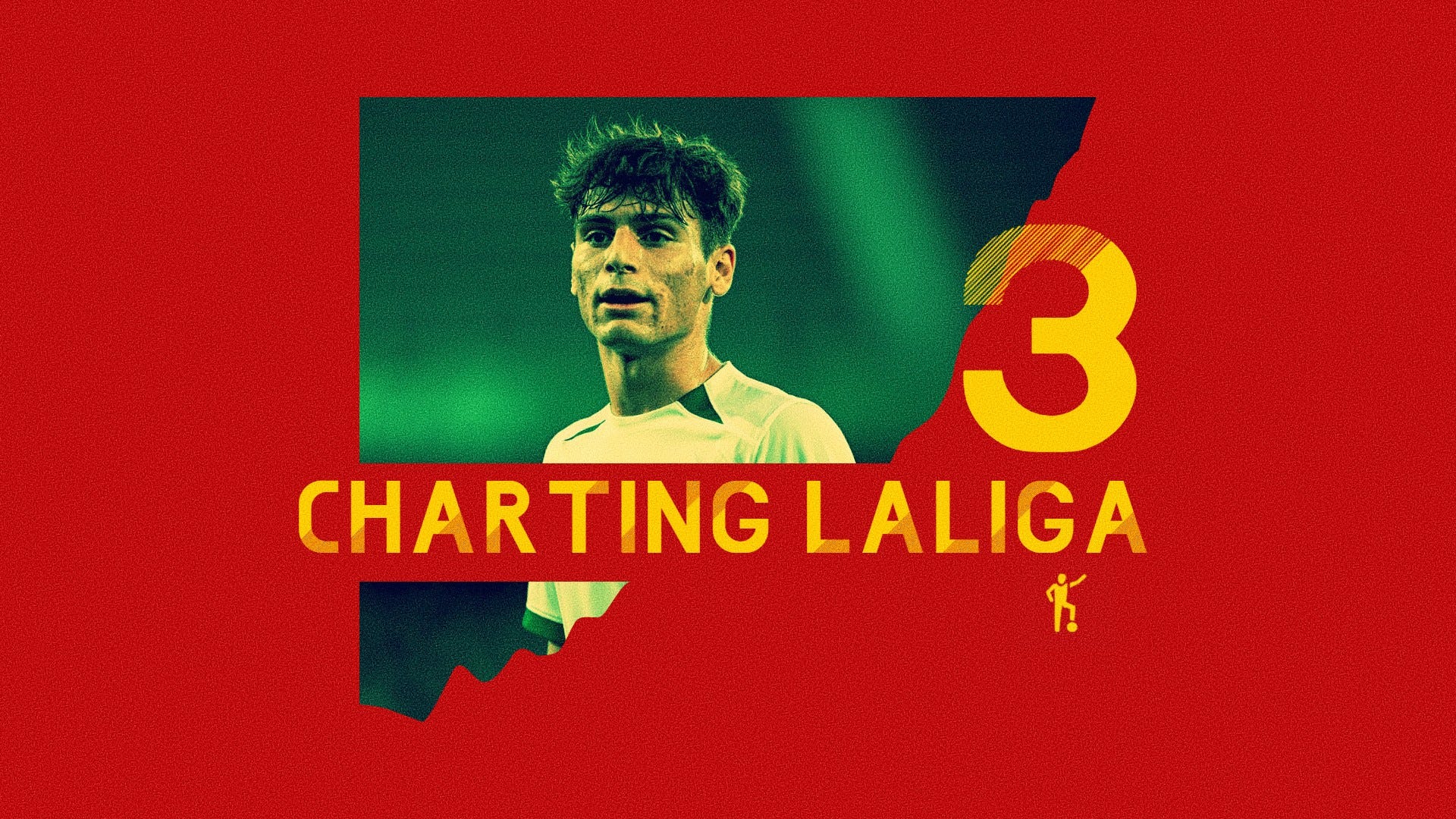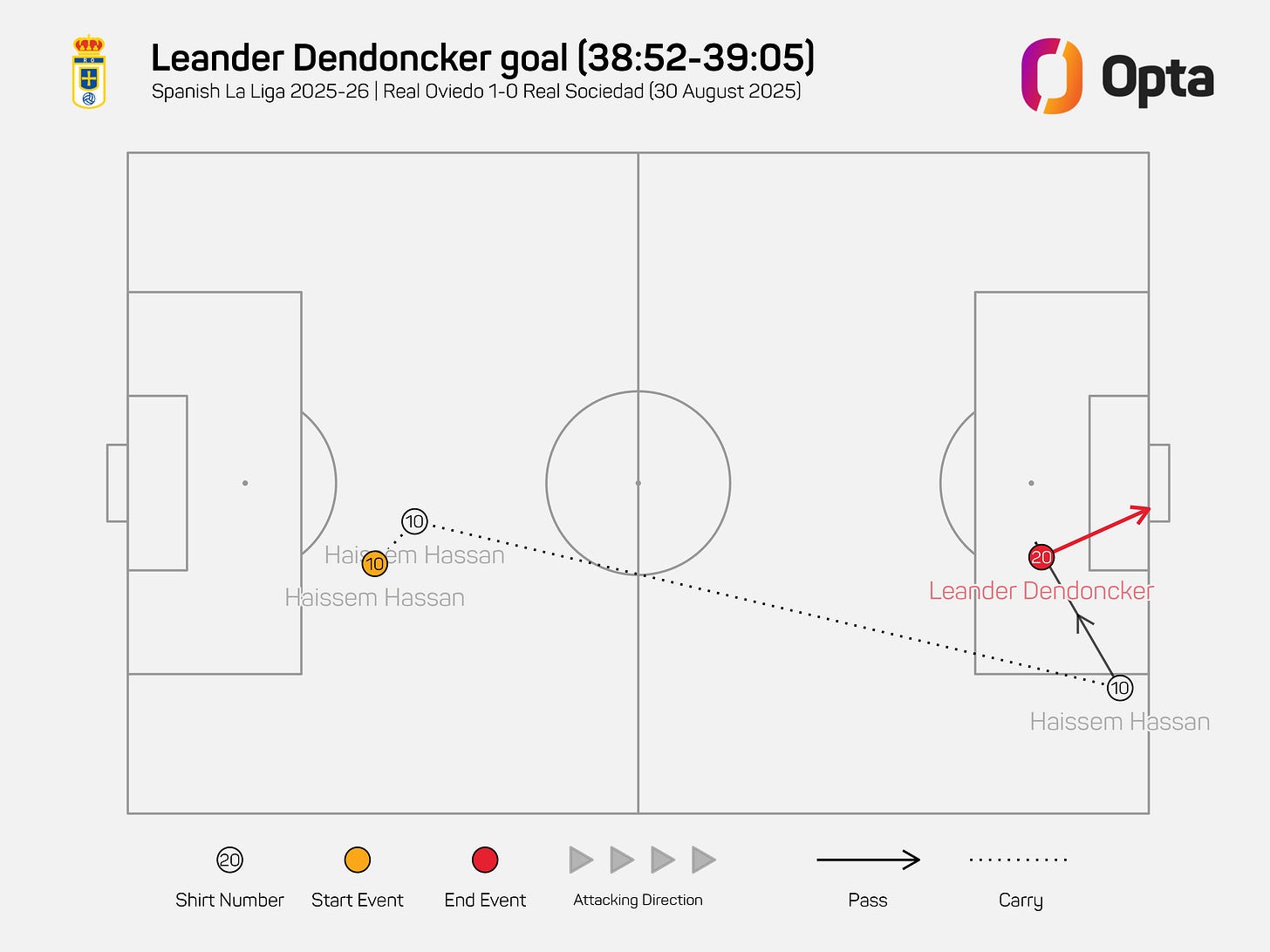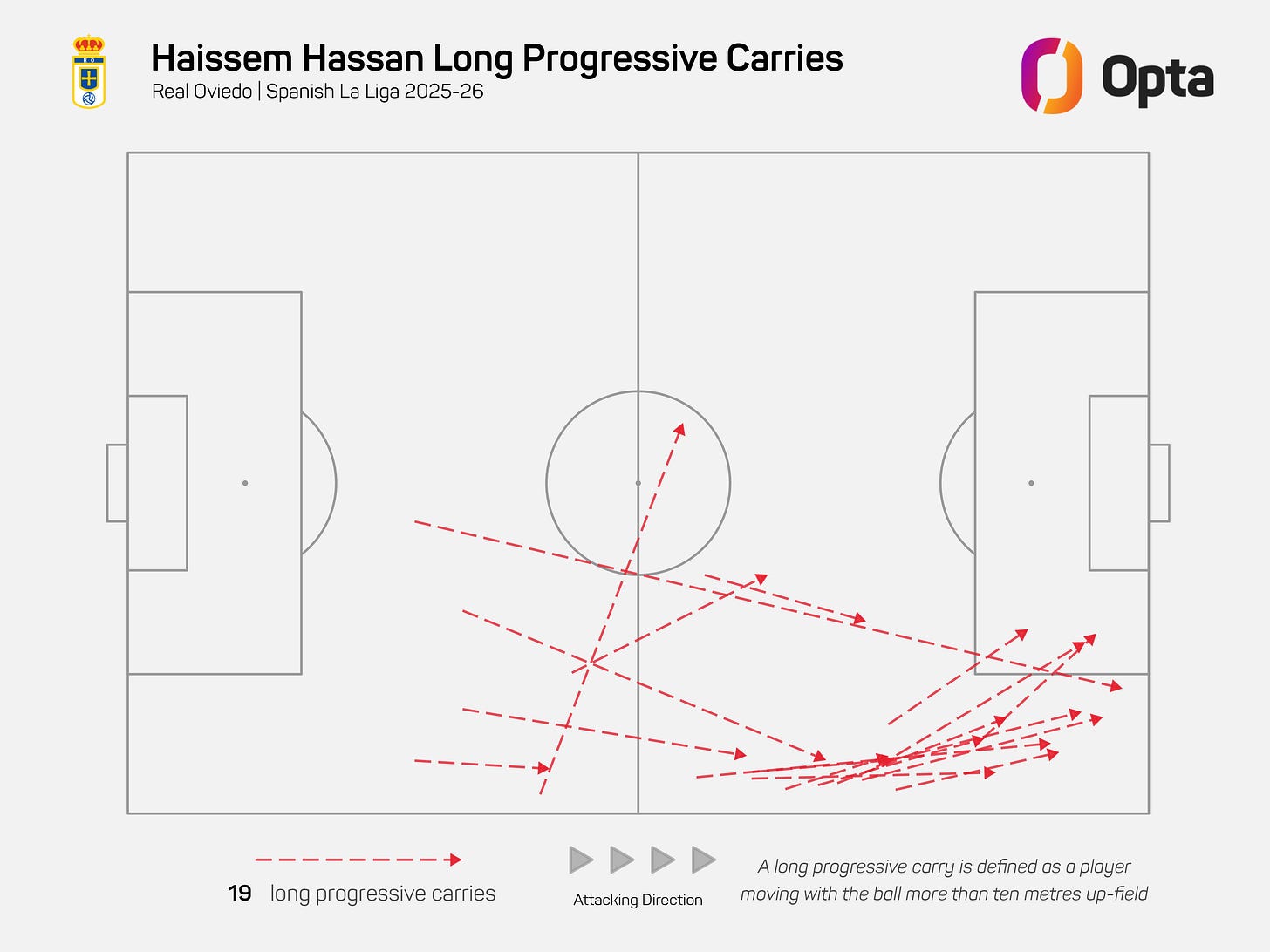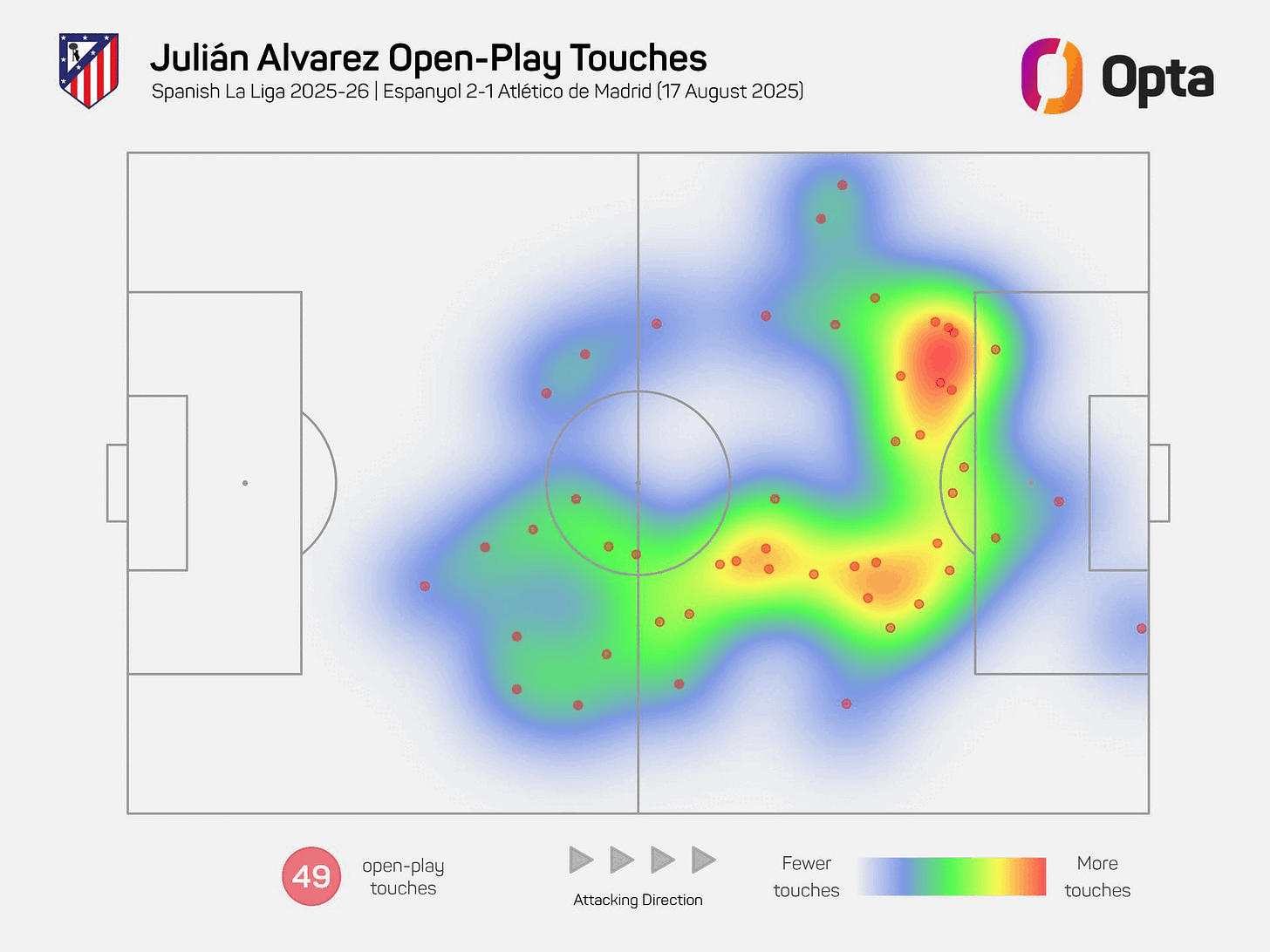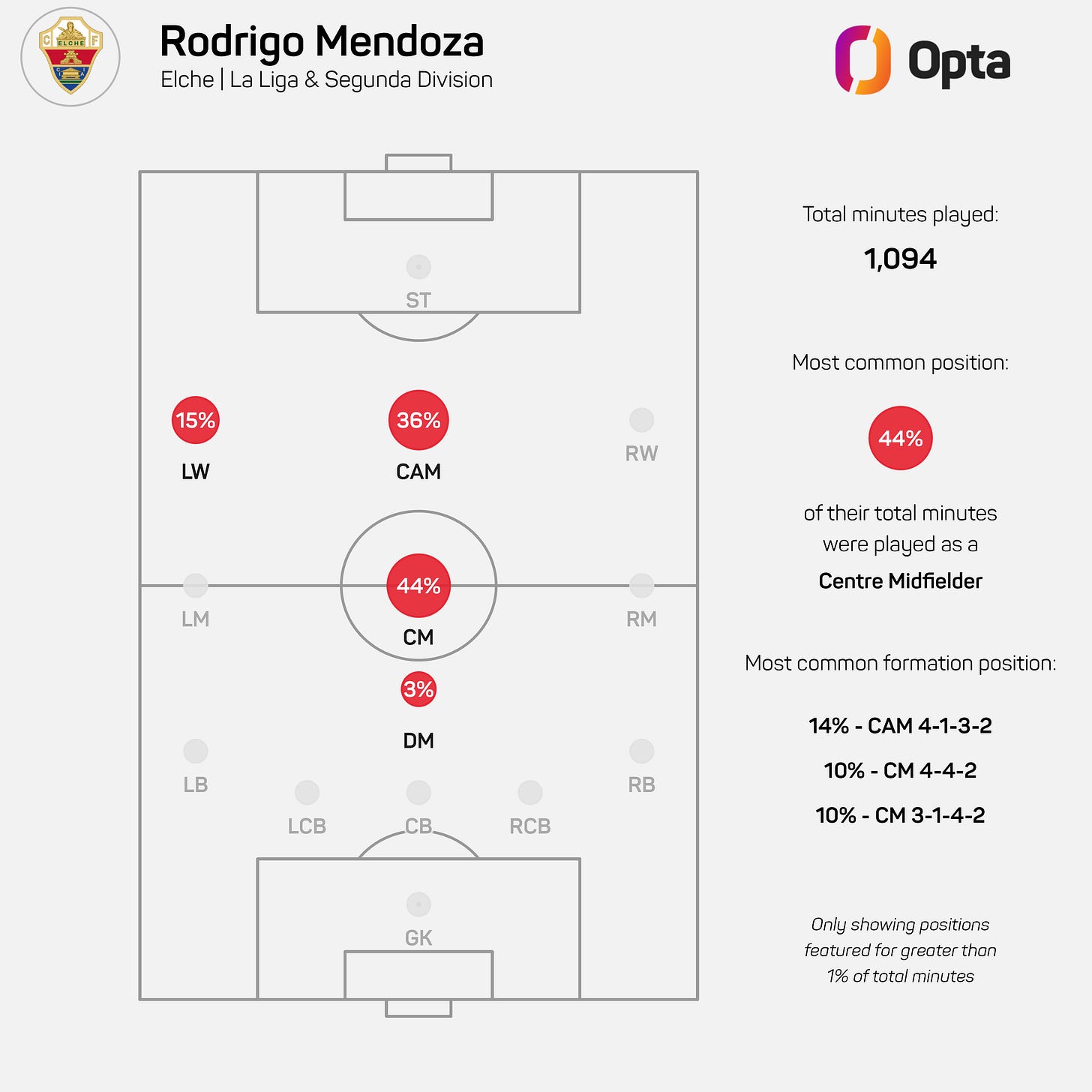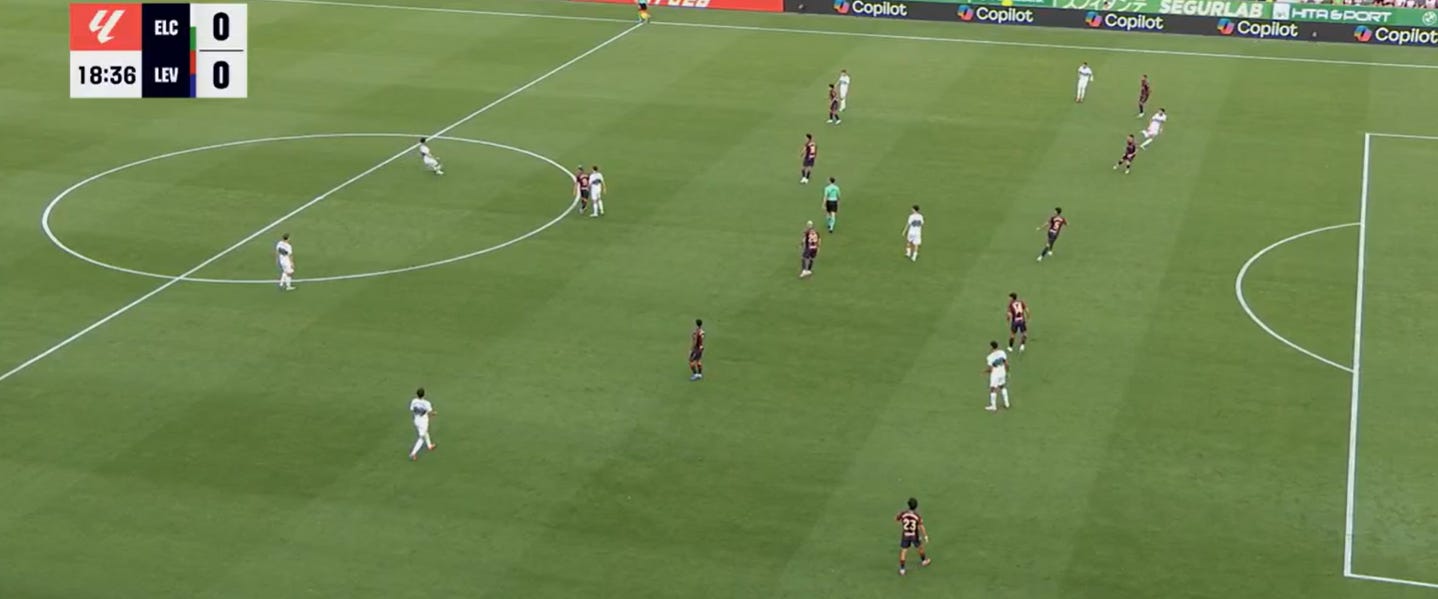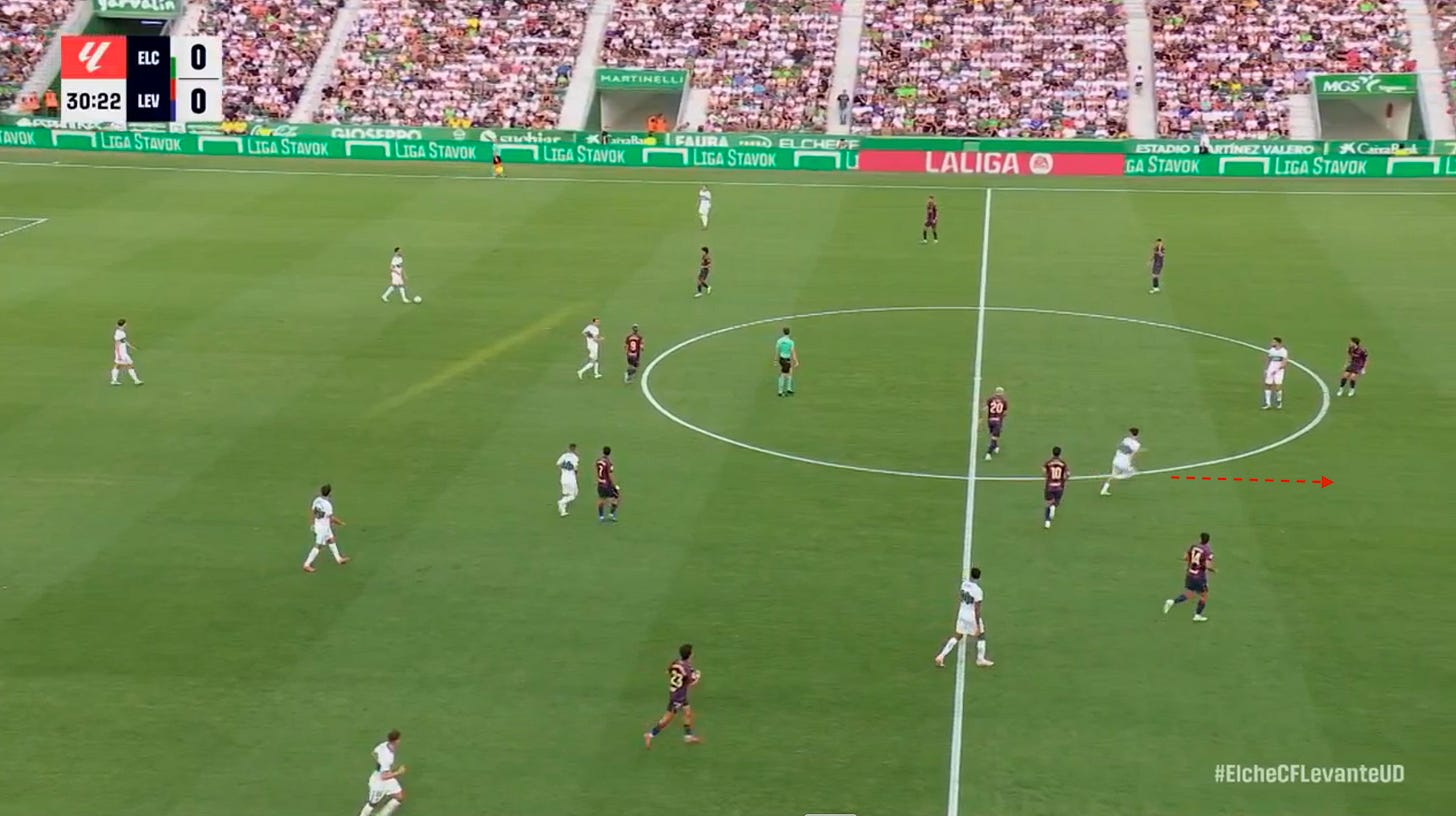Charting LaLiga #3: Gliding Rodrigo Mendoza, Barça's red flag, stuttering Atlético (& more)
A new addition to our coverage this season, Charting LaLiga will be a fixture after every matchday.
The premise is simple. Every week, we’ll churn out some points of interest from around the league in a (hopefully) digestible, easy-to-read manner. And of course, there will be a data element behind much of it.
Charting LaLiga will be a space for all types of insights, no matter the breadth of the topic or which team or player is under the spotlight. Sometimes they’ll be on the big themes everyone is aware of; other times they’ll be minuscule details that wouldn’t warrant an article of their own (but have a small place here).
All posts will typically be made up of anywhere between 3-6 sections, and you can expect these to land by Tuesday (following the usual Monday night fixture).
Any feedback, do let us know on here or X!
Barcelona’s big chance problem
Nobody who watched Barcelona regularly last season could conclude that Iñigo Martínez was a beneficial summer sale — at least from the view of sustaining team performance. Maybe it helped the club in financial terms and with managing registration issues, but there was little to no case for it on the playing front or for Hansi Flick’s peace of mind.
As it happens, Barcelona have since conceded more big chances than every other team in LaLiga (12 in three games); and a startling 11 more than rivals Real Madrid.
It’d be opportunistic of us to put all that on the absence of Iñigo. What it seemingly has done in the short term, however, is reduce Barcelona’s margin for error in a team that have decided a high-risk, high reward style of defending is their way and aren’t executing it well as a collective so far.
Indeed, even the mere fact of swapping out a player who played regularly at centre back last term — splitting up the Iñigo-Cubarsí duo — for at least one different player ought to be considered a hazard at this stage. The 34-year-old was the most senior member of the backline, clearest leadership presence, had 46 games worth of exposure to the offside trap-heavy style, and not to mention, was one of the best ball players from LCB in Europe last term (thus reducing giveaways and helping the team to spend more time attacking).
And here’s what Iñigo himself recently had to say about being part of a back line that defends the way it does. Evidently, even the most prepared and conditioned player to prop up the defensive line and live with the offside trap found it difficult.
“It’s true that when I was getting back after the games I couldn’t even sleep, given the tension that I had inside me… the stress it generates, having to be constantly aware of the opponent, and not only the opponent but the ball and the line…
“There were hours of work but it’s more about being alert and talking a lot. The back line has to be talking a lot, constantly…"
Go through this season’s tape, meanwhile, and there’s a variety of ways in which Barcelona have conspired to leak big chances behind their defensive line. There are various Lamine Yamal giveaways setting up transitions, long diagonals over the heads of full backs to bypass the initial press, overlapping runs from full backs starting in their own half, and quite evidently, a general decrease in the pop of their pressing coming out of pre-season that isn’t helping matters.
There are also ones that we’re seeing more than once, as early into the season as we are. A one-two on the flanks between a full back and winger, where either the defensive line isn’t high enough to play offside or the back four aren’t all moving in the same direction.
There’s certainly work to be done with their forward and midfield lines as far as pressing goes, but there’s still the sense that Flick’s side are more vulnerable when it is time to defend in their particular way. The type you’d expect when there’s a lack of familiarity between certain partnerships and players with less real time experience of defending in such a dynamic and unique manner.
And then there are instances when it has felt like Barça are simply gambling on the presence of the flag, rather than actively earning one.
Take this set piece against Levante — and specifically the role of captain Ronaldo Araújo, who ought to be taking the lead — for example:
Barça set their line, clearly with an offside call in their thoughts, yet make no actual movement to try increase their chances of bringing it into play. As the ball is coming in, Araújo is nowhere near being in position to either mark a Levante player and is instead busy appealing for an offside as Adrian de la Fuente tries to pick out the bottom corner.
Followers of the Flick era will know there were plenty of hair-raising moments last season too. Barça’s style of defending will never bring that number down to zero. But there’s only a certain amount of defence-opening lapses that this team will be able to absorb and still remain in the hunt for multiple trophies.
Expect it to improve in coming weeks and months with the chance to review the footage and make corrections — although not without some initial pain in the short term. Iñigo Martínez isn’t coming back.
JK
Haissem Hassan doesn’t want to be a sub anymore
“Put me on bench! Eh you, put me on the bench”! screamed Haissem Hassan in the direction of the Oviedo dugout, part celebrating his team’s opener against Real Sociedad and part letting off some steam.
Probably not advisable when your manager is the steely faced Serbian Veljko Paunović. But maybe after you had picked the ball up, ran the best part of 70 yards unopposed, then cut back a pass for a teammate to open the scoring in a game where your team had created nothing for 39 minutes, you too would feel similarly emboldened to defend your starting case.
To be fair to Paunović, it’s not that difficult to figure out why Hassan hasn’t been in the XI for the last two games. He’s a weak individual defender who is prone to lapses of attention, lacks appreciation of team-specific defending, and he’s not huge on running without the ball. In Oviedo’s first month back at the top level, Hassan doesn’t aid their priority of being a strong collective first and foremost.
On the other hand, Hassan significantly increases Oviedo’s chances of being able to get ahead in matches and then defend, as well as simply score a goal… as we saw on Saturday.
If the 23-year-old chips away at their defensive solidity, then we also have to acknowledge that he’s an enormous simplifier for the team’s attacking play.
As far as ball progression and take-on ability go, the distance between Hassan and the rest of his teammates is significant. In his 59 minutes on the pitch against Real Sociedad, he completed as many take-ons as all other Oviedo players combined (3), while Vinícius Júnior was the only winger on MD3 who had a higher total carry progress than him (224 metres upfield).
In fact, across the three matchdays so far, Hassan has accounted for a higher percentage of his team’s total carry progress than any other player (28%).
Whether they find him in transition or simply move the ball wide into the Frenchman against a set defence, Hassan has already shown he can be an individual advantage creator at this level.
That’s important in a promoted side where there’s always a doubt about final third quality, as well as allowing you to generate openings without having to take notable risks with your team shape and committing lots of numbers to attack; something that a promoted manager is inevitably hesitant to do.
Without anyone else intervening, Hassan can regularly haul Oviedo up the pitch with long carries and driving runs that back defenders down.
As we can see in the clip below, the ex-Villarreal man also has a great relationship with full back Nacho Vidal. Both players know how to play off and compliment each other’s movements, whether it’s Hassan wide and Vidal inside or vice versa.
The one guy who doesn’t need telling all of this, it should be said, is Veljko Paunović. If Oviedo want to score a goal, he knows better than anyone that a right side with Haissem Hassan increases their chances of doing so (especially if Vidal is there too).
The question he’ll be weighing up is whether Oviedo are a better football team with his high attacking impact and questionable defensive input, or whether the pros of the former are yet to override the latter.
JK
Transition problems ruin an improved Girona
Girona’s collapsing project showed signs of abating against Sevilla at the weekend, with an improved performance from Míchel’s side. The problem was, even being arguably the better side on the day, they still conspired to lose 2-0 against a Sevilla side that are far from convincing in their own way.
For the Catalans, it was again that dreaded word: transitions. Both of Sevilla’s goals came from attacks starting in their own half and had just two passes from start to finish, while both came against the run of play.
Speaking after the game, midfielder Iván Martín told LaLiga TV:
“We’re always going to have errors with the ball because we try to play and take control… [but] we’re putting a lot of emphasis on not letting transitions develop.
We have to make fouls and we haven’t — myself being the first with the first goal they scored. We need to correct that in any way we can because it’s the biggest error that’s hurting us.
“Our problem is still transitions. As much as we have players back there among the defence, and even with numerical superiority, they’re doing damage.”
As Iván Martín noted, Girona are always going to be prone to giveaways that force them to run backwards to some extent. It’s a natural consequence of playing high up the pitch: when the opponent recovers the ball, they have more immediate space to work with — provided they can put the first pass or two together.
For Míchel’s side, though, stopping those little fires before they turn into full blown infernos continues to be a problem.
In the opener against Sevilla, we can see a few of those lingering issues. Primarily, a lack of intensity to stop the move at the earliest point (including taking a foul), with Iván Martín not latching onto the touchline quick enough. And we can also see the lack of reaction and mobility from Axel Witsel, who ought to be thinking as a defensive shield in this side.
With his eyes fixed on the ball, he lets Rubén Vargas slip away into then what becomes a two-v-two problem at the back against a pair of quick Sevilla attackers.
Since their miraculous top four finish a few seasons ago, Girona’s asset-stripped squad has simply left them a much inferior version of what they once were — albeit without a change in Míchel’s main idea. Increasingly, they feel like a team optimised for building the game through the thirds (at the deficit of defensive specialists) who are more often suffering the cons of that than profiting from the pros.
The 2023-24 version had the quality to build the game, push the opposition back, and then keep them pinned there, meaning that even with generally non-specialist defenders, transitions didn’t plague them all that much. They attacked for longer and gave teams less juice to run the other way.
This one, unfortunately, is struggling to achieve any of the three aspects.
Through the first three matchdays of the new campaign, Girona have conceded the most fast breaks (10), shots from fast breaks (8) and conceded the most open play goals featuring three or fewer passes (7).
With a decreased ability to put teams on the back foot and keep them there, Girona’s defensive frailties come to the fore quick and often. And their toolkit for stopping those fast attacks — tactical fouls, more dedicated protection of the back four, stronger defensive profiles in the team — continues to look light. It’s instructive that they have already made 14 changes to the starting XI this term, with Míchel clearly hunting for solutions on the personnel front.
The more optimistic projection is that the goals should start to arrive more for Girona than what they have so far, which should help them battle their deficit. They were unlucky not to score against Sevilla. But while they remain short on that front, transitions will retain the potential to be a killer.
JK
Julián Álvarez and Atlético look unsure of themselves
Diego Simeone’s new-look Atlético Madrid has looked like exactly what it is through three games: a team in the middle of a reset. The performances have been uneven, and the patience that usually cushions this kind of process is already running thin. Zero wins from three games after a big summer outlay tends to zap patience pretty quickly.
Julián Alvarez, for one, has looked increasingly lost in the last couple of games. In the last two against Elche and Alavés, he has managed a single shot on target and has spent more time in deeper positions than anywhere near goal. The adjustment isn’t hard to trace: Alexander Sørloth’s introduction has shunted Alvarez aside and deeper. The swap has left the attack looking blunter and the players more frustrated.
There are a number of reasons why Atlético have struggled to impose themselves on any of their three opponents so far. Singling out one issue is both wrong and incomplete. However, Atlético’s build-up and ability to move the ball from front to back certainly isn’t helping matters. Outside of David Hancko’s impressive troubleshooting, they look tense and unsure of how to move the ball even under modest pressure.
And when they opt into going long, the pattern in recent games has been familiar: Jan Oblak goes over the top, Sørloth fails to connect, and possession is swiftly handed back to the opposition. What follows then are large gaps to try apply pressure and the sort of transitional defending problems that have tripped up Simeone’s teams before.
Below is an example of a goal kick where Atlético have 7v6 on the outfielder front, and are set up to play. Antonio Blanco (in the centre circle) is already retreating and if you include Oblak himself, you have more than enough for a considered build-up through a stretched out Alavés.
Instead, Oblak goes long, Sørloth misses the header, and Atlético are left trying to recover a loose ball with large distances between players.
With confidence clearly wavering and perhaps some lack of clarity on what Atlético are aiming to do, below is another example in open play where Oblak is going long when it seems fair to assume his team are in good condition to be playing short and building the game that way.
Barrios is pointing to the free left hand side, but it’s too late. Oblak has made up his mind.
As for the front two, the partnership of Alvarez and Sørloth generally feels awkward. Sørloth is being used as a fixed-point target man no. 9, which sends Álvarez away from the last line and into a more drifting in between role. Nor is there any semblance of synergy between them when occasional ‘front two’ moments appear: against Alavés, they exchanged just two passes.
When Antoine Griezmann came on as a left interior and Matteo Ruggeri offered more thrust on the flank than Hancko had previously, Álvarez looked liberated and more dangerous than he had — at least until he was subbed off, exhausted from chasing second balls and trying to conjure up the kind of magic players like the little Argentinean can occasionally do.
The good news is that the pieces to tweak tactics may not be far away. Nico González, the deadline day arrival, profiles as either a second striker or a winger, which should reposition Álvarez back into his centre forward role and the exit of Sørloth who continues to underwhelm as a starter. Álex Baena’s return will be crucial, too; even in a mere 68 minutes against Espanyol, we saw him connecting nicely with Álvarez in what were — not coincidentally — their best minutes of the season by far.
Baena created two chances for Álvarez in that cameo versus Espanyol, which is just one fewer than the rest of his Atlético teammates combined across three matches this season (3).
After the break, Atlético face Villarreal and then Liverpool at Anfield where the impulse to exercise caution is predictably high. We know how Diego Simeone often responds to adversity. But the version of this team that exists now — rigid, lacking connection, and short on attacking chemistry — neither looks sustainable for a team who are already facing the necessity of results, on top of stylistic consideration.
RD
Rodrigo Mendoza is hard to define
Things are going well for Rodrigo Mendoza. A new contract at Elche, his first LaLiga goal against Levante last time out, a Spain under-21 call-up, and then an invitation to train with the senior side shortly after. Enough in seven days to fill an entire C.V. His star is most definitely on the rise.
We know that Mendoza is a fantastic talent; something which he’s continuing to prove now he’s stepped up to the big time. The reality, however, is that we’re not all that sure of what he’s going to be. After 923 minutes in the Segunda last season and three starts in the top-flight this year, there’s still a hugely open book on what his best role might be, where he’s most effective, and where he’ll eventually land for the brunt of a career that looks increasingly well primed.
For now, the comparison that we like most is a young Pedri at Las Palmas (before being put on the path to becoming a world class, box-to-box master interior).
The flashes of vision and control in tight spaces, the ability to turn into pressure and find an exit route, his drifting into areas to make himself an option — and even the difficulty in defining his best role because of his wide array of skills.
In the last two seasons, he’s split time starting from a wide position and as a central attacking midfielder, as well as playing in deeper roles.
As we’ve seen in the opening weeks of the season, Elche offers the youngster an excellent place to develop on the job too. From the vision of coach Eder Sarabia, their position-heavy style of football has set them up with a strong early platform — they’re playing the game on their terms for long spells and allowing the likes of Mendoza to be influential in interpreting space, rather than hunkered behind the ball or having to deal with direct balls from the back.
Elche rank fourth for average sequence time so far (12.4 seconds); only behind Real Madrid, Barcelona and Celta Vigo. They’re patient and ultra positional, with their way of playing putting a big emphasis on subtlety of movements to pick up on weaker spots in the opposition shape.
The 3-5-2 they’ve opened the season with is beneficial for Mendoza’s specific talents too. With a front two of Rafa Mir and Álvaro Rodríguez occupying up to three centre backs at a time, he is is typically the one to take advantage of any spaces that open up behind the opposition midfielders.
Against Atlético Madrid and particularly Levante — two teams who drop into a back five — Elche and Mendoza profited hugely from that space in between the lines. Mir and Rodríguez switched between occupying outside CBs and running into the channels, while the youngster picked up on the gaps (usually when the middle CB was reticent to step out).
Sometimes those gaps didn’t appear, and Mendoza’s response was to move sideways and to drag markers like Oriol Rey out of position, before combining on the sides. With two centre forwards in the box, any inroads he can make there are obviously beneficial. And indeed, one of those moves did lead directly to a goal that would have stood without an illegal nudge from Rafa Mir.
The numbers are also illustrative of both Mendoza’s role and his productivity. He received 11 progressive passes on MD1 against Betis; the joint-most by a player in a single game across the first three rounds. Similarly, no midfielder has received more in open play (19) overall so far. And you can throw in a healthy return of seven completed take-ons, four open play chances created, four fouls won and a goal on his stat line too.
The specifics of his position and long-term usage may still be unsettled, but that will be of concern to precisely nobody at this stage. It’s bound to make itself evident along the way. And in the meantime, the structure around him is already tilting to give him ample room to figure it out.
Sarabia eased him into the fold last season with just under 1,000 minutes, and now — even on the big stage — isn’t worried about giving him the keys the kingdom as a featured player.
RD




